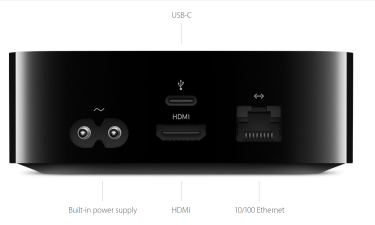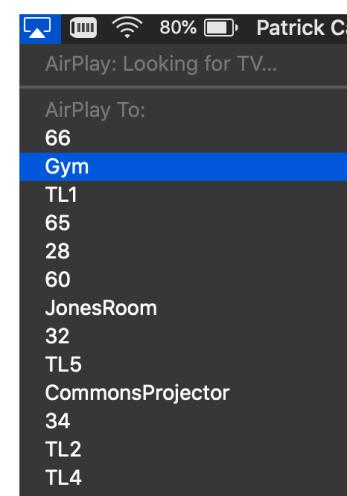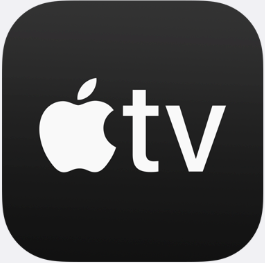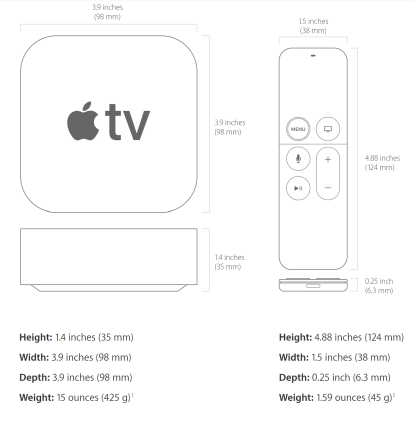Streaming in the classroom: Apple TV
Ah yes, the Apple TV. This is currently what we are using in my school and while it is pretty good there are problems I will get into. First, let’s talk about what is, what it does, how much it costs and all that good stuff.
Cost: $149 USD
Here are the different connection types on the back.
 As you can see pretty good stuff here but a dedicated audio out would be nice like they had on some of the older models the HDMI always makes things easy.
As you can see pretty good stuff here but a dedicated audio out would be nice like they had on some of the older models the HDMI always makes things easy.
There is a 4K version as well for $179 USD.
How they work
The Apple TV is not only a streaming box (like a Roku or Firestick) but it also has the ability to extend or mirror a teacher’s MacBook or iPad/iPhone. This technology is called AirPlay and it is built into all Apple devices (except the Apple Watch).
You can’t do this with a Windows computer or Android device. This feature only works with Apple products.
The good thing here is that it is built into the operating systems. There is no app or program to launch. It is just there. On a Mac it looks like this.
As you can see all those listed are separate Apple TVs. We have set up a little security on each that requires the user to input a 4 digit code that the Apple TV randomly generates and displays on the screen. This helps keep unwanted people from joining or accidentally joining.
Where it shines
The Apple TV shines if you have a school that uses primarily Apple devices. This is not a surprise to anyone. From a tech department stand point we merely connect it to our projectors through a receiver and then plug it into power and do minimal configuration (changing the name, setting up the security PIN code option, etc.) and then we basically leave it alone and it just works. It is very simple and for the staff or students, using the Apple TV (which requires just connecting their Apple device to it) is very simple, requires minimal training and the results are pretty good.
The price is also a great feature. When a school or organization is looking for a way to let their users share their screen with a common display you will not find much out there that is as good.
The quality of the image and the quality of streaming video is also very good. The image and the sound match up seamlessly and there is little lag when just displaying your desktop screen.
Where it falters
When the Apple TV does not work it just doesn’t work. We have had times when it does not show up in the Airplay list. No reason why it does this and it requires us to unplug it back in. Sometimes it shows up but will not a connection. Again, there is no setting or reason why this is happening, it just happens and we usually perform a power cycle (turn it off and back on again by unplugging it).
Sometimes it just disconnects from an active screen. While it is a box that just sits there, it is also very much a black box that we cannot peer into. We have no idea why it performs this way or what causes it. This makes managing many of them in a networked environment a little problematic.
From and tech department standpoint, they are difficult to manage remotely. You would need to use a mobile device management (MDM) solution like Filewave to manage them and the options you can control are pretty minimal. I don’t believe that we can power cycle these devices remotely even with an MDM solution.
Also, there is no power button. If we want to restart the Apple TV we have to walk to the classroom, unplug it, plug it back in and then wait for it to reboot. A power button or a quick way to restart it would be awesome.
Also, being able to brand it would be nice. A lot of solutions will let you have a splash screen or a screen where your school name and logo are presented. Not the Apple TV. It does have a conference room mode which hides the Apple TV video options but it is replaced with a video screen saver of a flyover of famous cities around the world (this is mesmerizing by the way).
Finally, the most obvious shortcoming of the Apple TV – it only works with Apple laptops, desktops, iPads and iPhones. I’m not talking about AirPlay which has found itself in a number of Sony, Samsung screens. I’m talking about taking a computer, smartphone or tablet other than an Apple and sharing your screen to it. It’s not going to happen.
You have Chromebooks? Forget it. You have a guest speaker with a Windows device? Nope. It does this to help lock you in and as a school you may not have nor want that total lock in. We have teachers on staff who want a Windows device and the Apple TV in the mix throws a wrench into their plans.
Summing it up
The Apple TV is a really good device for streaming and sharing ones screen if your school is heavily invested in Apple products. Despite its shortcomings this may be the best option for you. Sure, they can be a bit of a pain to manage, but their reliability and long life (we have some in our building that over five years old!) they are quite the bargain.
If you are in a BYOD situation or use a lot of Windows, this is not feasible for you. If you’re currently a Mac school but even thinking about the possibility of switching down the road, then avoid it. That lock in situation is very real and having options is good.
If you want it to do more than just share a screen, then look elsewhere. I’m not sure if you will find anything that can that is near the price point of an Apple TV but you can look – that’s what we are doing and why I’m chronicling this search!
Please leave comments below – all criticisms and points of view are welcome!
Source: IT Babble Blog and Podcast


You must be logged in to post a comment.